Mechanical and Microstructural Changes in Expansive Soils Treated with Lime and Lignin Fiber from Paper Industry
Abstract
1. Introduction
2. Materials and Methods
2.1. Test Materials
2.2. Sample Preparation
3. Test Scheme
4. Test Results Analysis
4.1. Analysis of the Results of Lignin Fiber-Improved Soil
4.1.1. Unconfined Compressive Strength Test
4.1.2. Direct Shear Test
4.1.3. Hydraulic Conductivity Test
4.1.4. Microstructure Investigations
4.2. Analysis of Test Results of Lignin Fiber–Lime Composite-Improved Soil
4.2.1. Unconfined Compressive Strength Test
4.2.2. Direct Shear Test
4.2.3. Hydraulic Conductivity Test
4.2.4. Microstructure Investigations
5. Conclusions
- The addition of lignin fibers significantly increases the compressive strength of the expansive soils, with an optimum fiber content of 8%. In contrast, the mixture treatment of 8% lignin fibers and 2% lime further elevates the compressive strength of the soil by approximately 50% compared to the soil treated with 2% lime alone.
- Similarly, the 8% lignin fiber-treated sample presents a maximum soil cohesion of 210 kPa. As for the mixture treatment, the soil treated with a composite of 2% lime and 8% lignin fibers has a cohesion increase of 12% compared to the soil treated with 2% lime alone.
- The treatment with lignin fibers increased the hydraulic conductivity of the soils by increasing the porosity of the soil. However, the lignin fiber- and lime composite-treated soil shows a relatively lower hydraulic conductivity than the soil only treated with lime, which can be attributed to the denser microstructure after the composite treatment.
- The microstructure investigations indicated that the treatment of lignin fibers can enhance the soil microstructure by creating a strong network that fills the pores between soil particles. Furthermore, the addition of lime will improve the microstructure through cementitious materials, which adhere to the surfaces of the fibers and form bonds between the fibers and the soil particles. These mechanisms contribute to a significant increase in the soil strength.
- The use of lignin fibers and lime, either alone or in combination, can significantly improve the hydro-mechanical properties of expansive soils. It provides an ecological and sustainable potential method of reusing industrial byproducts in the field of soil stabilization.
- Future research should include further tests such as bearing ratio and water stability tests to enhance our understanding of soil performance under different conditions. Additionally, exploring the variability in soil properties like water content and dry density across different environmental settings will be crucial for applying these findings to real-world scenarios.
Author Contributions
Funding
Institutional Review Board Statement
Informed Consent Statement
Data Availability Statement
Conflicts of Interest
References
- Jones, L. Expansive Soils. In Selective Neck Dissection for Oral Cancer; Techniques in Dentistry and Oral & Maxillofacial Surgery; Springer International Publishing: Cham, Switzerland, 2018; pp. 1–7. [Google Scholar]
- Sun, D.A.; Zhang, J.R.; Lv, H.B. Soil-water characteristic curve of Nanyang expansive soil in full suction range. Geotech. Mech. 2013, 34, 1839–1846. [Google Scholar]
- Wei, J.; Wei, J.; Huang, Q.; Zainal Abidin, S.M.I.B.S.; Zou, Z. Mechanism and Engineering Characteristics of Expansive Soil Reinforced by Industrial Solid Waste: A Review. Buildings 2023, 13, 1001. [Google Scholar] [CrossRef]
- Wang, C.H.; Cha, W.H.; Wang, J.J. Summarization of swelling and shrinkage mechanism and new treatment methods of expansive soil. Subgrade Eng. 2020, 6–11. [Google Scholar] [CrossRef]
- Soltani, A.; Deng, A.; Taheri, A. Swell–Compression Characteristics of a Fiber–Reinforced Expansive Soil. Geotext. Geomembr. 2018, 46, 183–189. [Google Scholar] [CrossRef]
- Gao, L.; Hu, G.H.; Yang, C.; Xiang, C. Shear strength characteristics of basalt fiber reinforced clay. Chin. J. Geotech. Eng. 2016, 38, 231–237. [Google Scholar]
- Zhao, J.Y.; Kong, Y.P.; Gao, X.H. Study on Shear Strength and Interface Quantity Characteristics of Coir Fiber Reinforced Soil. J. Highw. Transp. Res. Dev. 2023, 40, 36–44. [Google Scholar]
- Tiwari, N.; Satyam, N.; Puppala, A.J. Effect of Synthetic Geotextile on Stabilization of Expansive Subgrades: Experimental Study. J. Mater. Civ. Eng. 2021, 33, 04021273. [Google Scholar] [CrossRef]
- Zumrawi, M.; Babikir, A. Laboratory Study of Steel Slag Used in Stabilizing Expansive Soil. Asian Eng. Rev. 2017, 4, 1–6. [Google Scholar] [CrossRef]
- Alnmr, A.; Ray, R.P.; Alsirawan, R. A State-of-the-Art Review and Numerical Study of Reinforced Expansive Soil with Granular Anchor Piles and Helical Piles. Sustainability 2023, 15, 2802. [Google Scholar] [CrossRef]
- Yang, J.; Li, X.C.; Zhang, G.D.; Tang, Y.W. Experimental study on expansion characteristics of expansive soil improved by weathered sand. J. Yangtze River Sci. Res. Inst. 2013, 30, 67–72. [Google Scholar]
- Lv, J.H.; Yang, Z.N.; Shi, W. Study on the Influence of Soil Sample Thickness on the Crack Evolution Law of Rubber Reinforced Expansive Soil. J. Eng. Geol. 2022, 30, 1140–1147. [Google Scholar]
- Dong, B.L.; Huang, H.H.; Pei, S.W.; Xu, Y.Z. Experimental Study on Expansion Characteristics of Gravel-Improved Expansive Soil. J. Undergr. Space Eng. 2018, 14, 1213–1217. [Google Scholar]
- Zhao, H.; Chu, F.C.; Ye, H.; Guo, K.L. Experimental study on basic physical properties of expansive soil improved by industrial waste. Sci. Technol. Eng. 2017, 17, 230–235. [Google Scholar]
- Eyo, E.; Abbey, S.; Oti, J.; Ng’ambi, S.; Ganjian, E.; Coakley, E. Microstructure and Physical-Mechanical Characteristics of Treated Kaolin-Bentonite Mixture for Application in Compacted Liner Systems. Sustainability 2021, 13, 1617. [Google Scholar] [CrossRef]
- Baglari, D.; Dash, S. Improvement of expansive soil by lime and reinforcement. In Proceedings of the Indian Geotechnical Conference, Roorkee, India, 24 December 2013. [Google Scholar]
- Chen, L.; Zhang, F.H.; Fan, Y.Z.; Li, J.N. Experimental study on expansion characteristics and mechanical properties of lime-improved expansive soil compacted samples. Sci. Technol. Eng. 2014, 14, 269–272. [Google Scholar]
- Zhan, Y.L.; Huang, Z.; Liu, S.Y. Experimental Study on Cement Modified Expansive Soil in Anyang. Sci. Technol. Eng. 2013, 13, 7418–7421. [Google Scholar]
- Estabragh, A.R.; Rafatjo, H.; Javadi, A.A. Treatment of an Expansive Soil by Mechanical and Chemical Techniques. Geosynth. Int. 2014, 21, 233–243. [Google Scholar] [CrossRef]
- Cheng, D.; Reiner, D.M.; Yang, F.; Cui, C.; Meng, J.; Shan, Y.; Liu, Y.; Tao, S.; Guan, D. Projecting Future Carbon Emissions from Cement Production in Developing Countries. Nat. Commun. 2023, 14, 8213. [Google Scholar] [CrossRef] [PubMed]
- Chen, C.; Guo, W.; Ren, Y.X. Study on the properties and microscopic analysis of lignin fiber modified soil under freeze-thaw cycle conditions. Geotech. Eng. 2020, 42, 135–140. [Google Scholar]
- Xie, T.; Zhao, K.; Wang, L. Reinforcement Effect of Different Fibers on Asphalt Mastic. Mater. Basel Switz. 2022, 15, 8304. [Google Scholar] [CrossRef]
- Peng, B. Application of methyl cellulose in bituminous mixtures. J. Xi Univ. Archit. Technol. Nat. Sci. Ed. 2005, 37, 104–107. [Google Scholar]
- Xie, M.J.; Wen, Y.T.; Xu, L.L.; Wu, K. Composite Modification with Cellulose Fiber/Glass Fiber to Enhance the Pavement Performance ofAsphalt Concrete. J. Build. Mater. 2023, 26, 1200–1206. [Google Scholar]
- Moslemi, A.; Tabarsa, A.; Mousavi, S.Y.; Monfared, M.H.A. Shear Strength and Microstructure Characteristics of Soil Reinforced with Lignocellulosic Fibers-Sustainable Materials for Construction. Constr. Build. Mater. 2022, 356, 129246. [Google Scholar] [CrossRef]
- Dong, C.F.; Lin, C.; Zhang, W.Y.; Sun, X.L.; Huang, Y.L. Study on thermal and mechanical properties of lignin fiber modified loess in cold and arid regions. Resour. Environ. Arid Reg. 2022, 36, 119–126. [Google Scholar]
- Dong, C.F.; Zhang, W.Y.; Zhang, R.X.; Huang, Y.L. Experimental study on mechanical and thermal properties of lignin fiber modified loess under freeze-thaw action. Permafr. Glacier 2022, 44, 612–622. [Google Scholar]
- Dong, J.; Chen, Y.; Wu, Z.H.; Yang, H. Experimental study on the shear strength and deformation characteristics of ligninfiberred clay. J. Geomech. 2019, 25, 421–427. [Google Scholar]
- Chen, Y.H.; Cai, W.; Ou, M.X. Experimental study on expansive soil improved by lignin fiber-high calcium fly ash composite. J. Saf. Environ. 2023, 1–11. [Google Scholar] [CrossRef]
- Fan, K.W.; Yan, J. Study on strength characteristics and microstructure of lignin fiber modified expansive soil in seasonal frozen area. J. Cent. South Univ. Nat. Sci. Ed. 2022, 53, 326–334. [Google Scholar]
- Jha, A.K.; Sivapullaiah, P.V. Lime Stabilization of Soil: A Physico-Chemical and Micro-Mechanistic Perspective. Indian Geotech. J. 2020, 50, 339–347. [Google Scholar] [CrossRef]
- Gong, J.L.; Liu, H.X.; Wang, Z. Study on the Compressive and Mechanical Properties of Expansive Soil Improved by Lime. J. Transp. Sci. Eng. 2022, 38, 35–40. [Google Scholar]
- Howard, A.K. Soil Classification Handbook: Unified Soil Classification System; Geotechnical Branch, Division of Research and Laboratory Services, Engineering and Research Center, Bureau of Reclamation: Denver, CO, USA, 1986.
- GB/T 50123-2019; Standard for Geotechnical Testing Method. Ministry of Water Resources of the People’s Republic of China. China Planning Press: Beijing, China, 2019.
- Gao, Z.N.; Wang, Q.; Zheng, L. Effect of sample preparation and mixing method on strength of lignin fiber modified loess. J. Earthq. Eng. 2021, 43, 930–934. [Google Scholar]
- Marcuello, C.; Foulon, L.; Chabbert, B.; Aguié-Béghin, V.; Molinari, M. Atomic Force Microscopy Reveals How Relative Humidity Impacts the Young’s Modulus of Lignocellulosic Polymers and Their Adhesion with Cellulose Nanocrystals at the Nanoscale. Int. J. Biol. Macromol. 2020, 147, 1064–1075. [Google Scholar] [CrossRef] [PubMed]
- Topçuoğlu, Y.A.; Gürocak, Z. Increasing Strength of Clay Soils with the Use of Basalt Fiber: An Experimental Study. Turk. J. Sci. Technol. 2024, 19, 87–96. [Google Scholar] [CrossRef]
- Dong, C.F.; Zhang, W.Y.; Sun, X.L. Experimental Study on the Shear Strength of Lignin Fiber Improved Loess. Saf. Environ. Eng. 2022, 29, 102–110. [Google Scholar]
- Song, Y.; Geng, Y.; Dong, S.; Ding, S.; Xu, K.; Yan, R.; Liu, F. Study on Mechanical Properties and Microstructure of Basalt Fiber-Modified Red Clay. Sustainability 2023, 15, 4411. [Google Scholar] [CrossRef]
- Wang, D.Y.; Tang, C.S.; Li, J. Shear strength characteristics of fiber-reinforced unsaturated cohesive soils. Chin. J. Geotech. Eng. 2013, 35, 1933–1940. [Google Scholar]
- Maher, M.H.; Ho, Y.C. Mechanical Properties of Kaolinite/Fiber Soil Composite. J. Geotech. Eng. 1994, 120, 1381–1393. [Google Scholar] [CrossRef]
- Miller, C.J.; Rifai, S. Fiber Reinforcement for Waste Containment Soil Liners. J. Environ. Eng. 2004, 130, 891–895. [Google Scholar] [CrossRef]
- Wei, L.; Chai, S.; Xue, M.; Wang, P.; Li, F. Structural Damage and Shear Performance Degradation of Fiber–Lime–Soil under Freeze–Thaw Cycling. Geotext. Geomembr. 2022, 50, 845–857. [Google Scholar] [CrossRef]
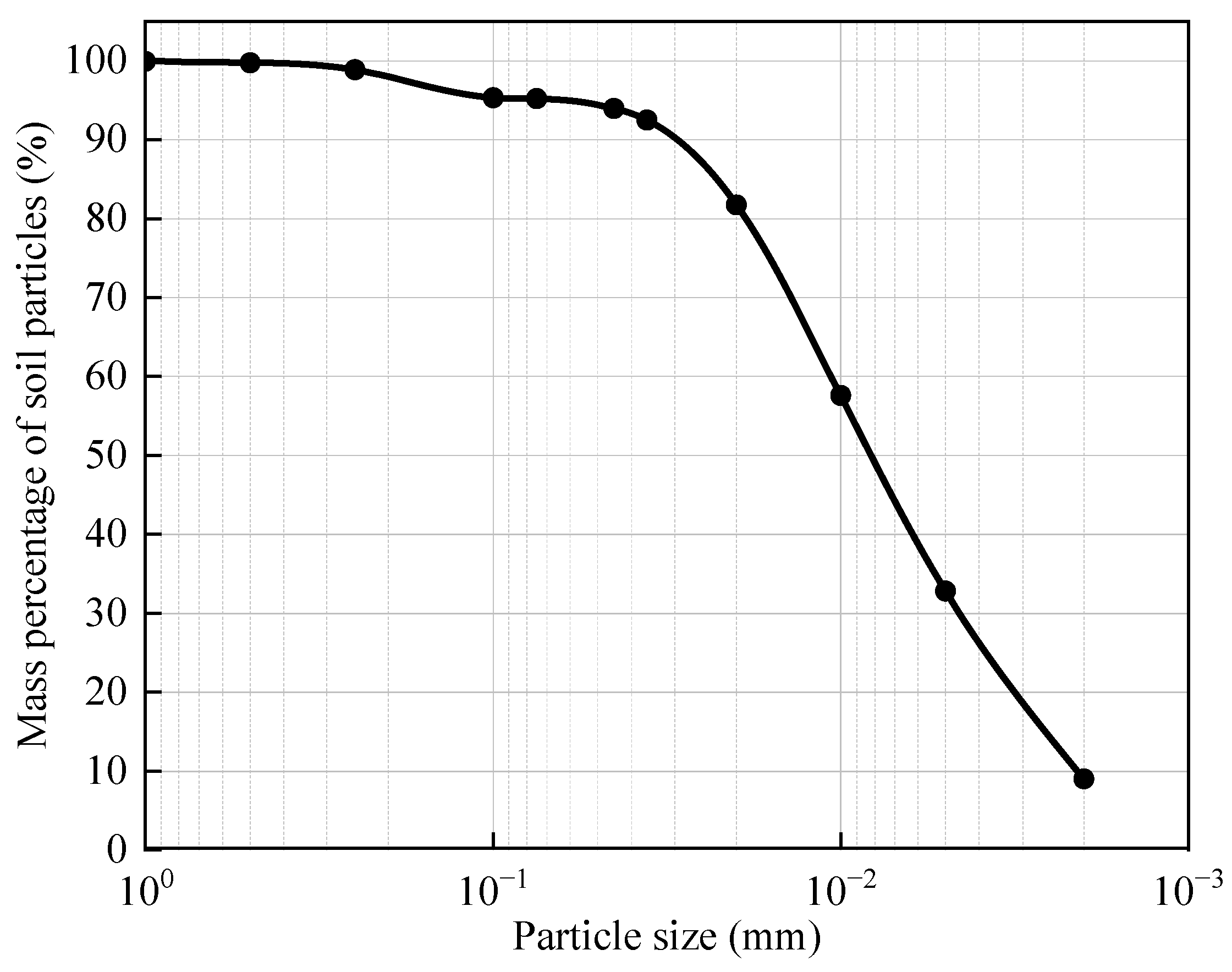
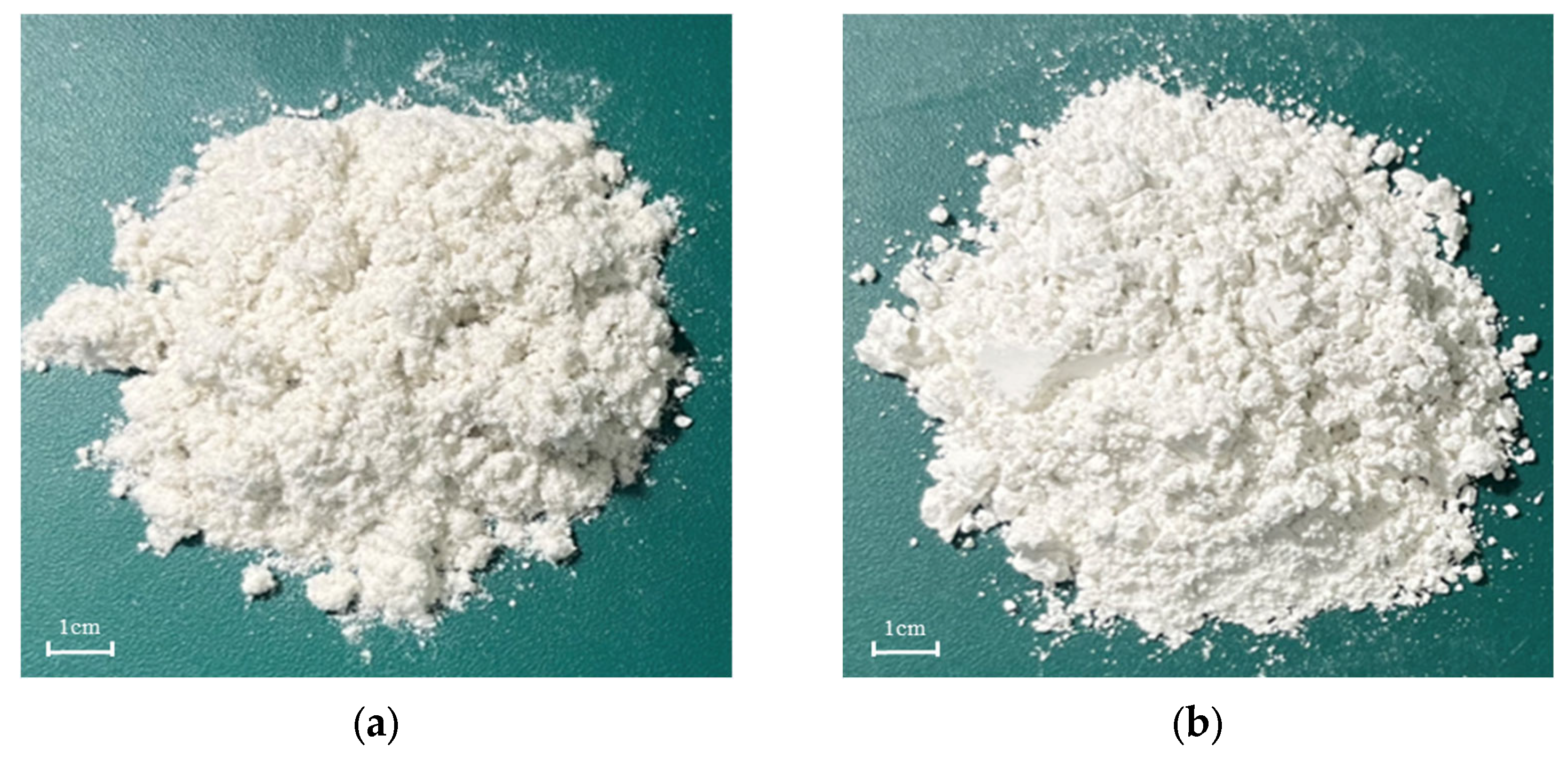

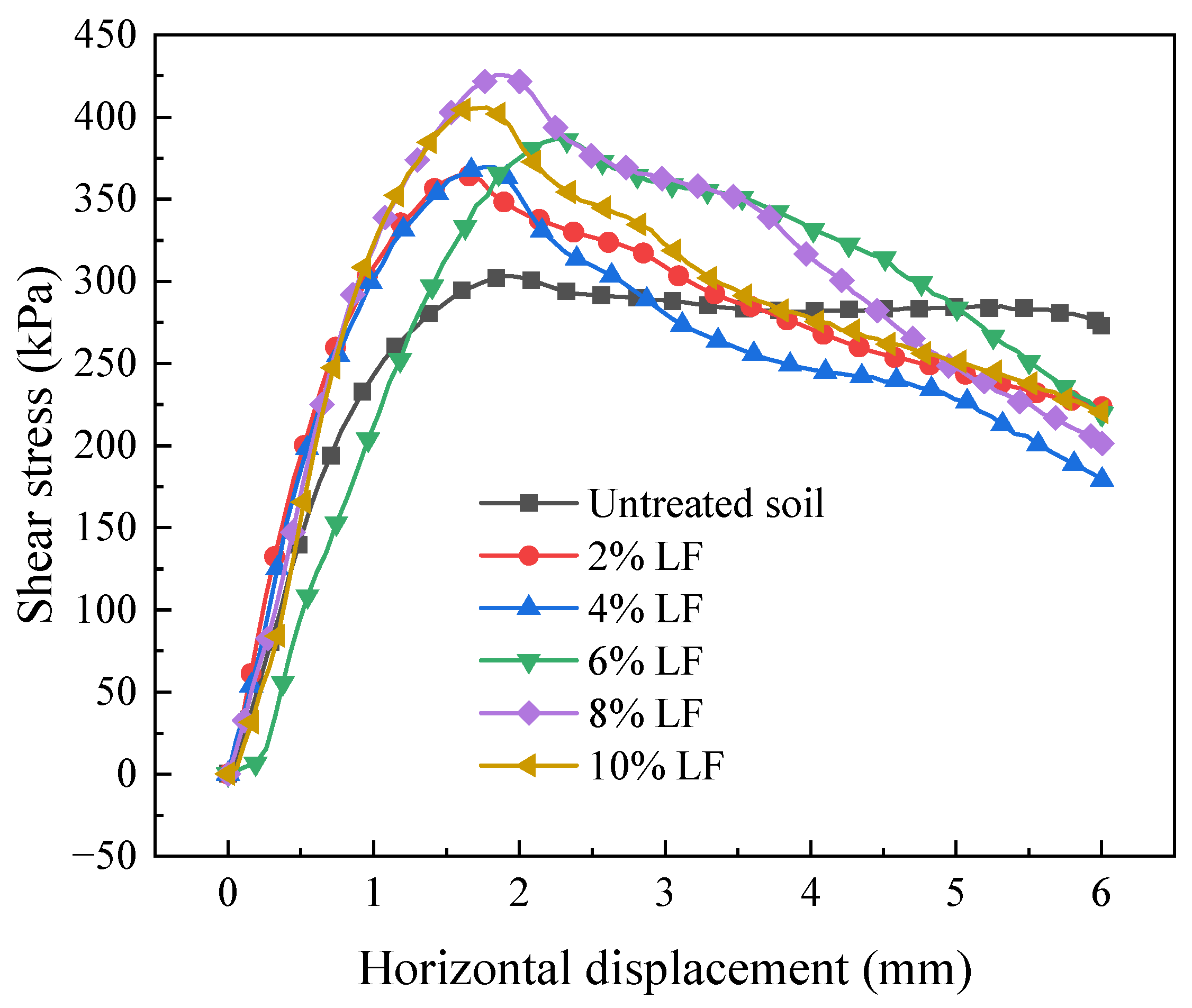
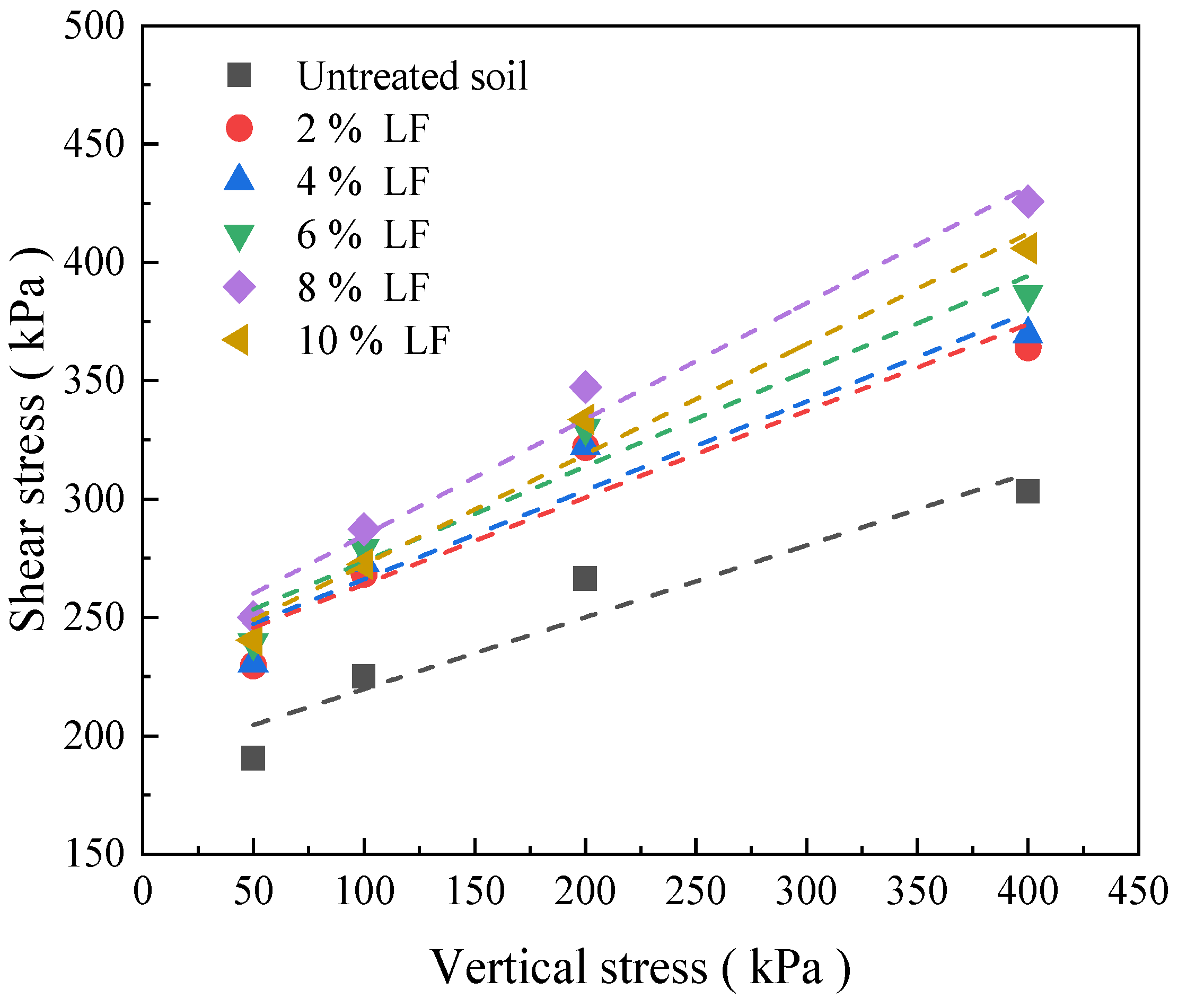

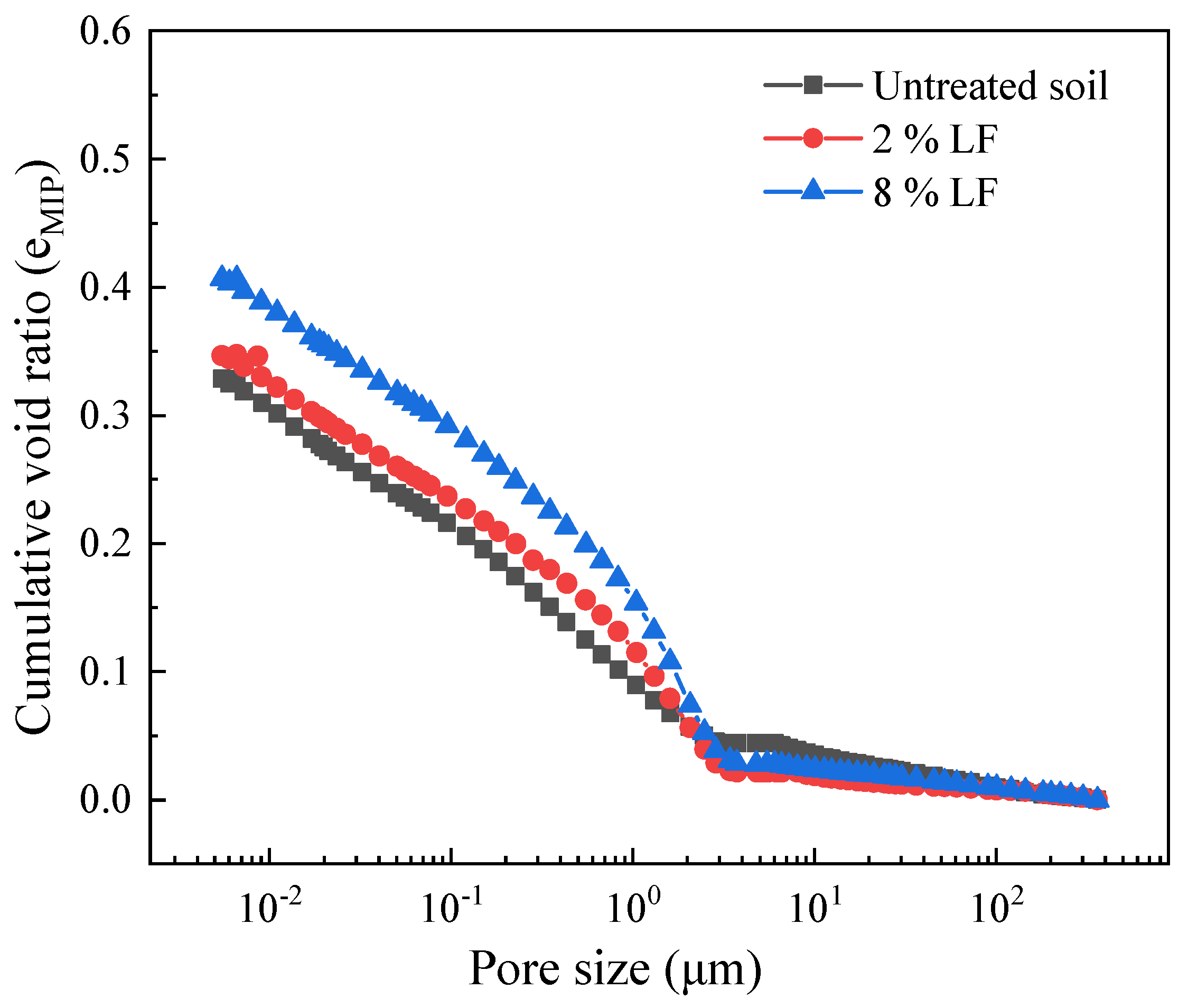
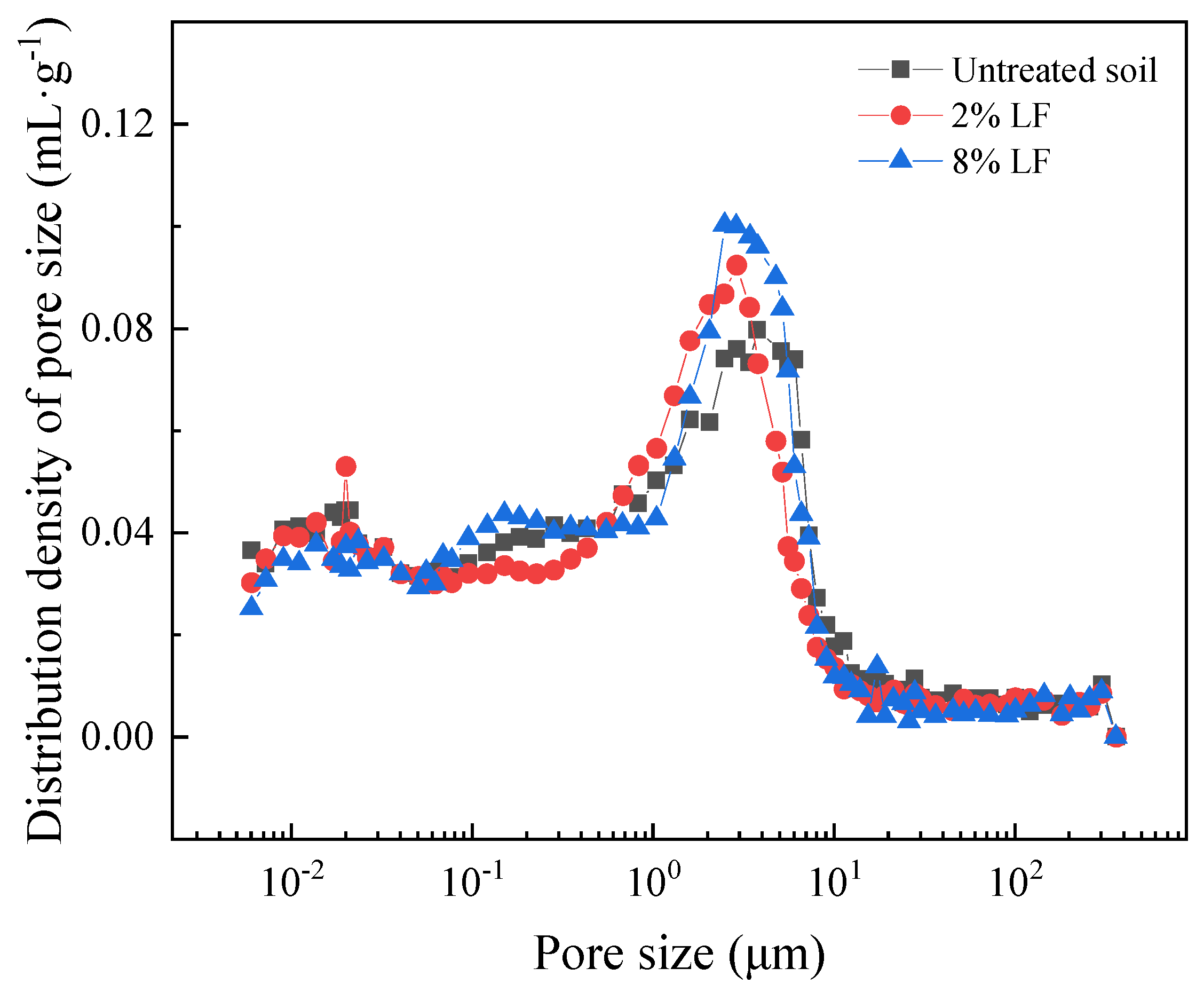
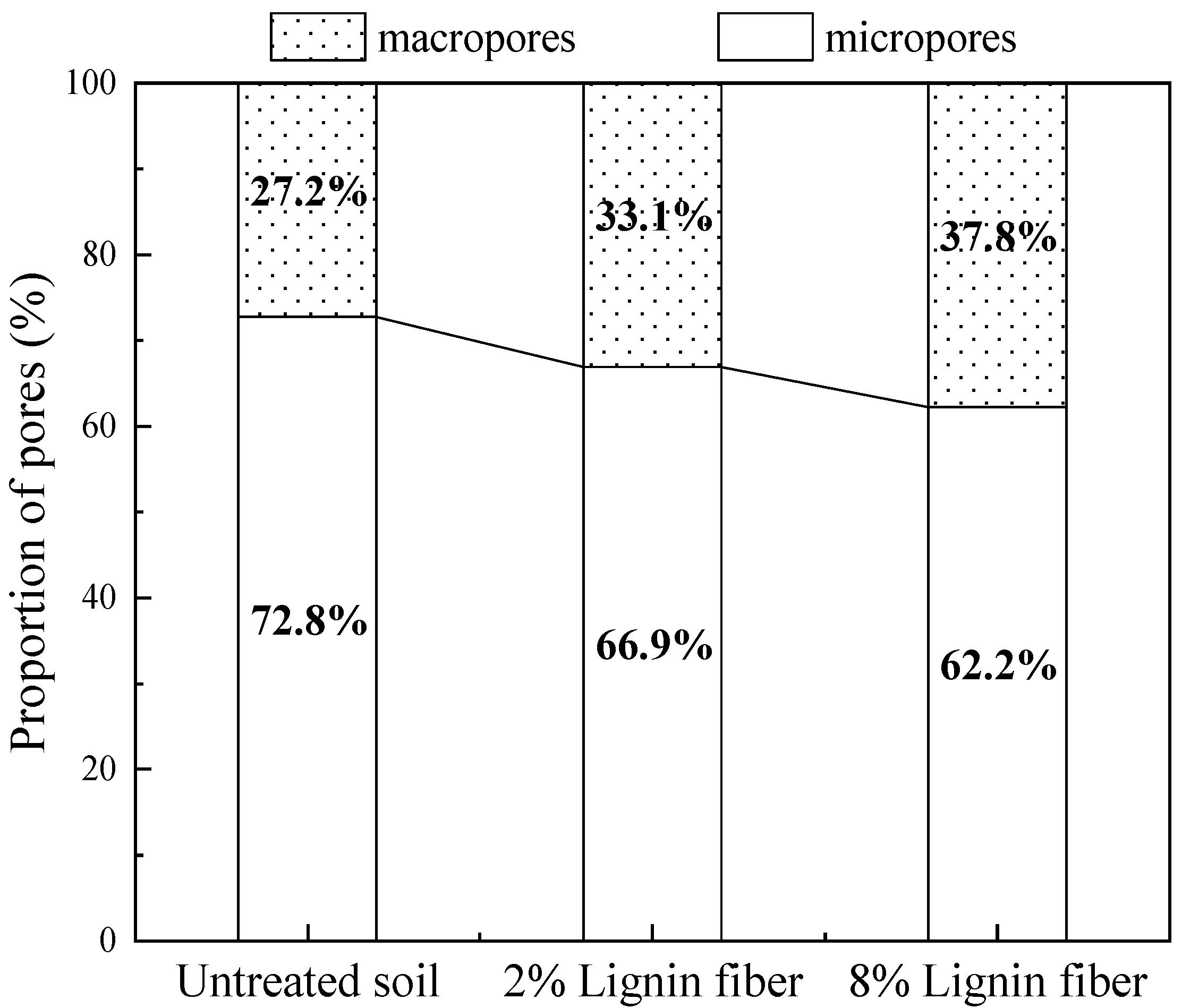
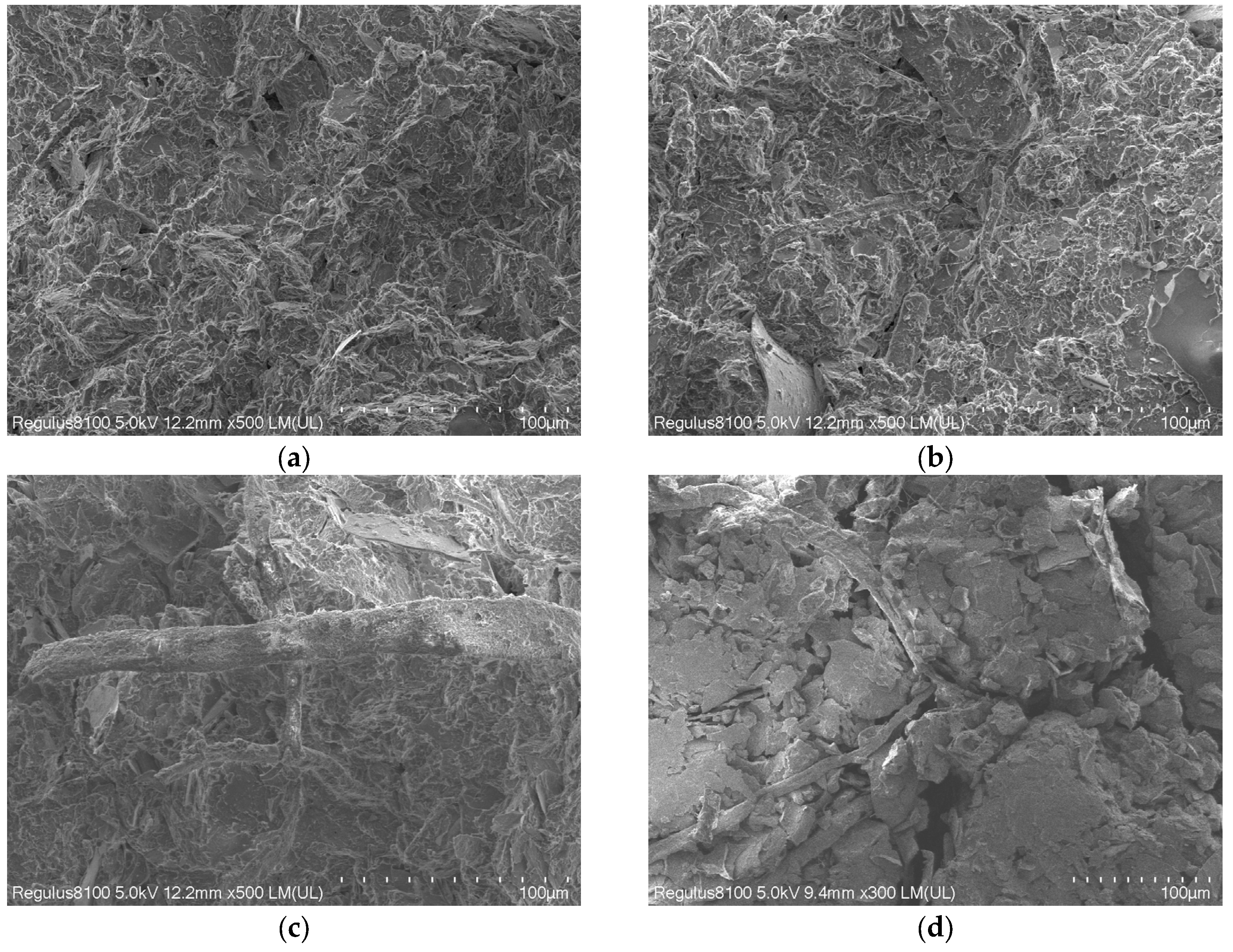
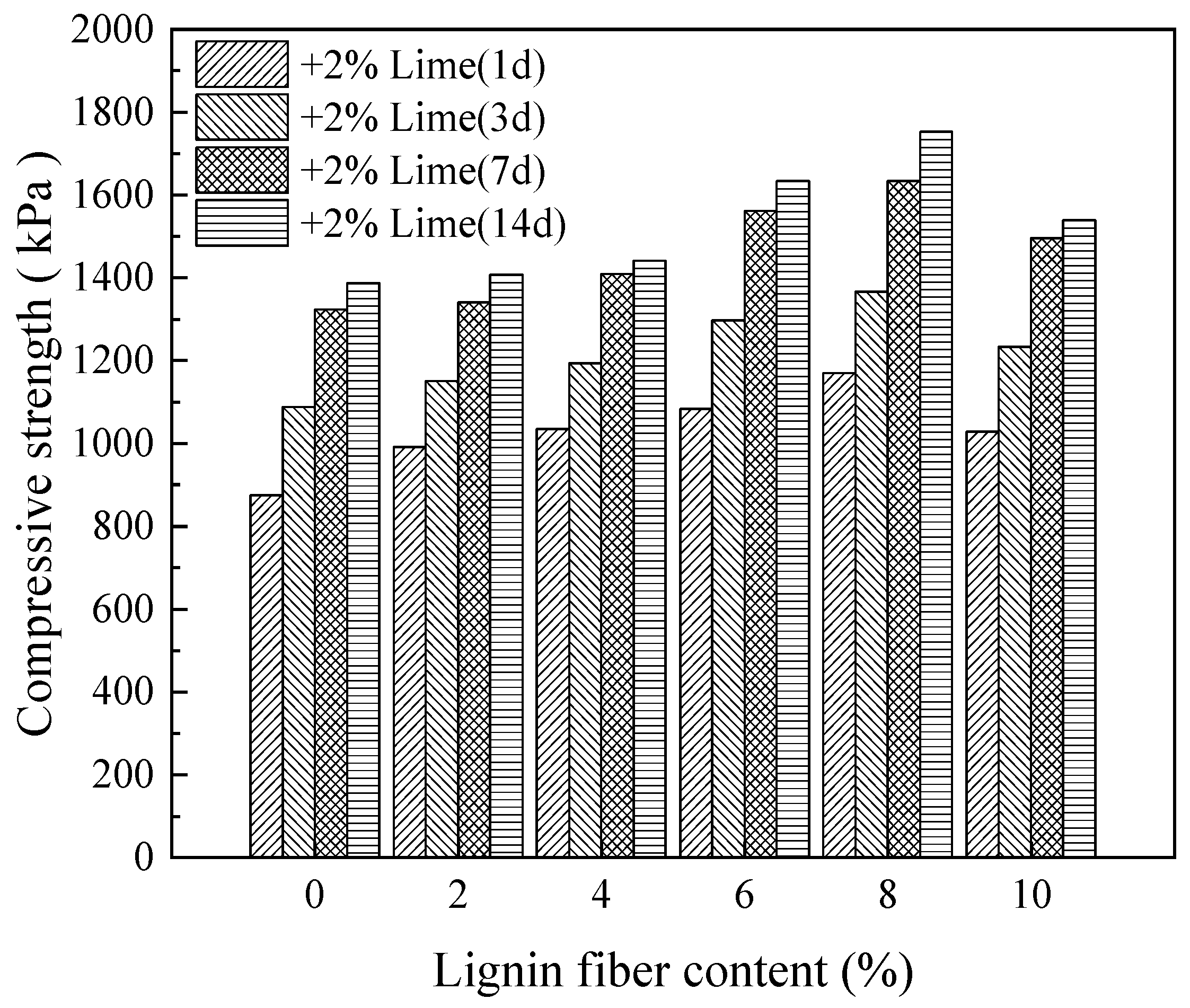

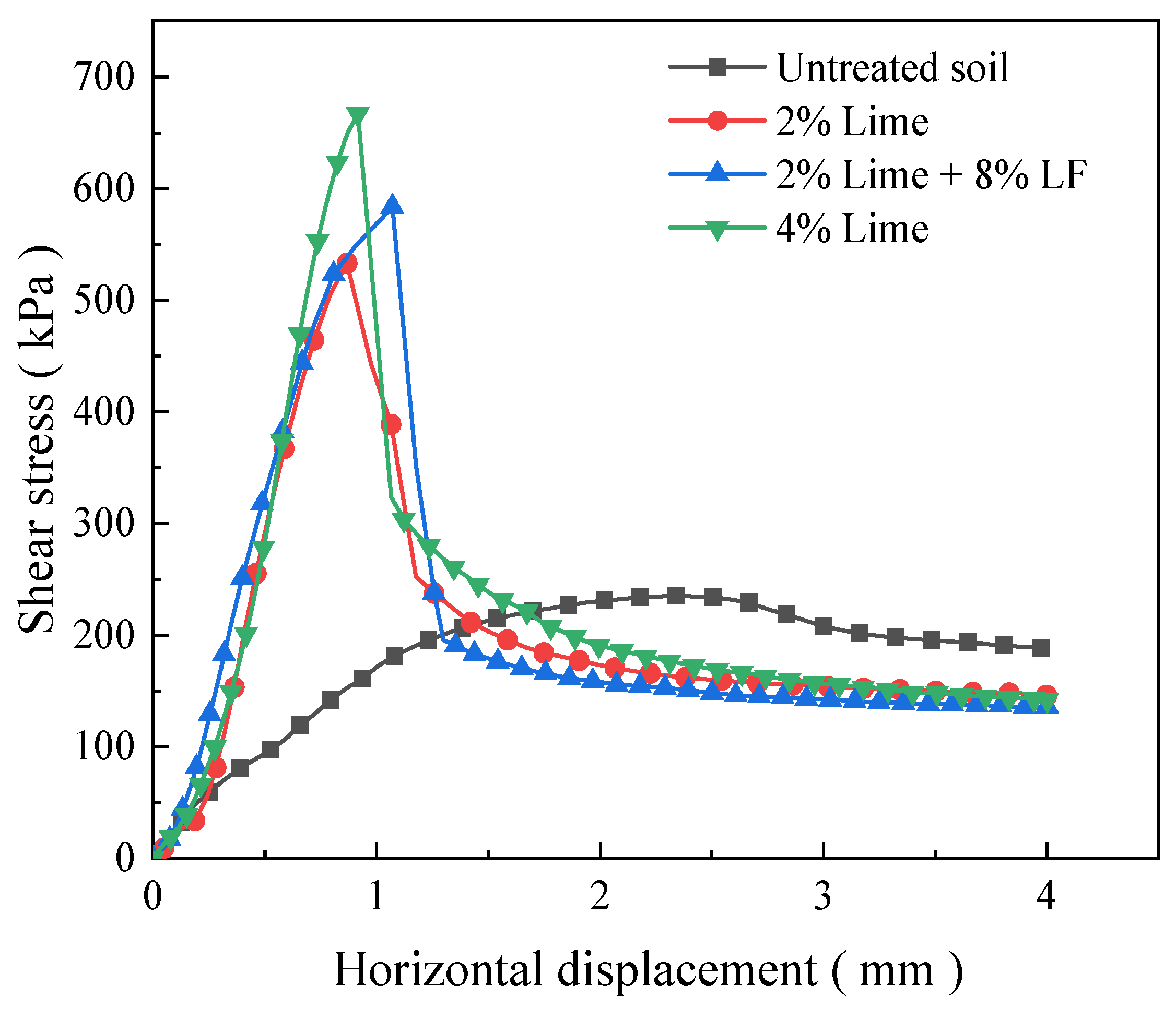
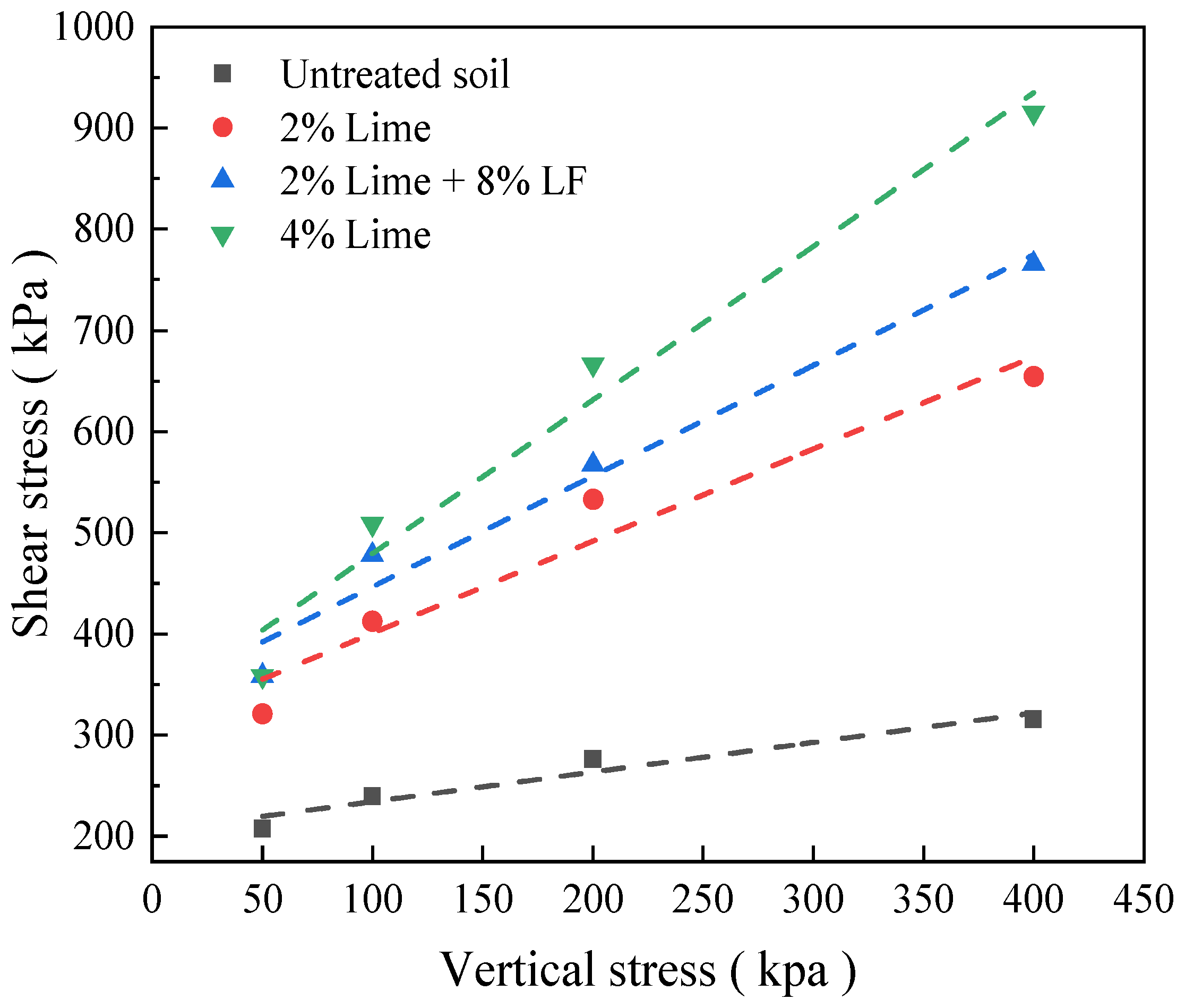
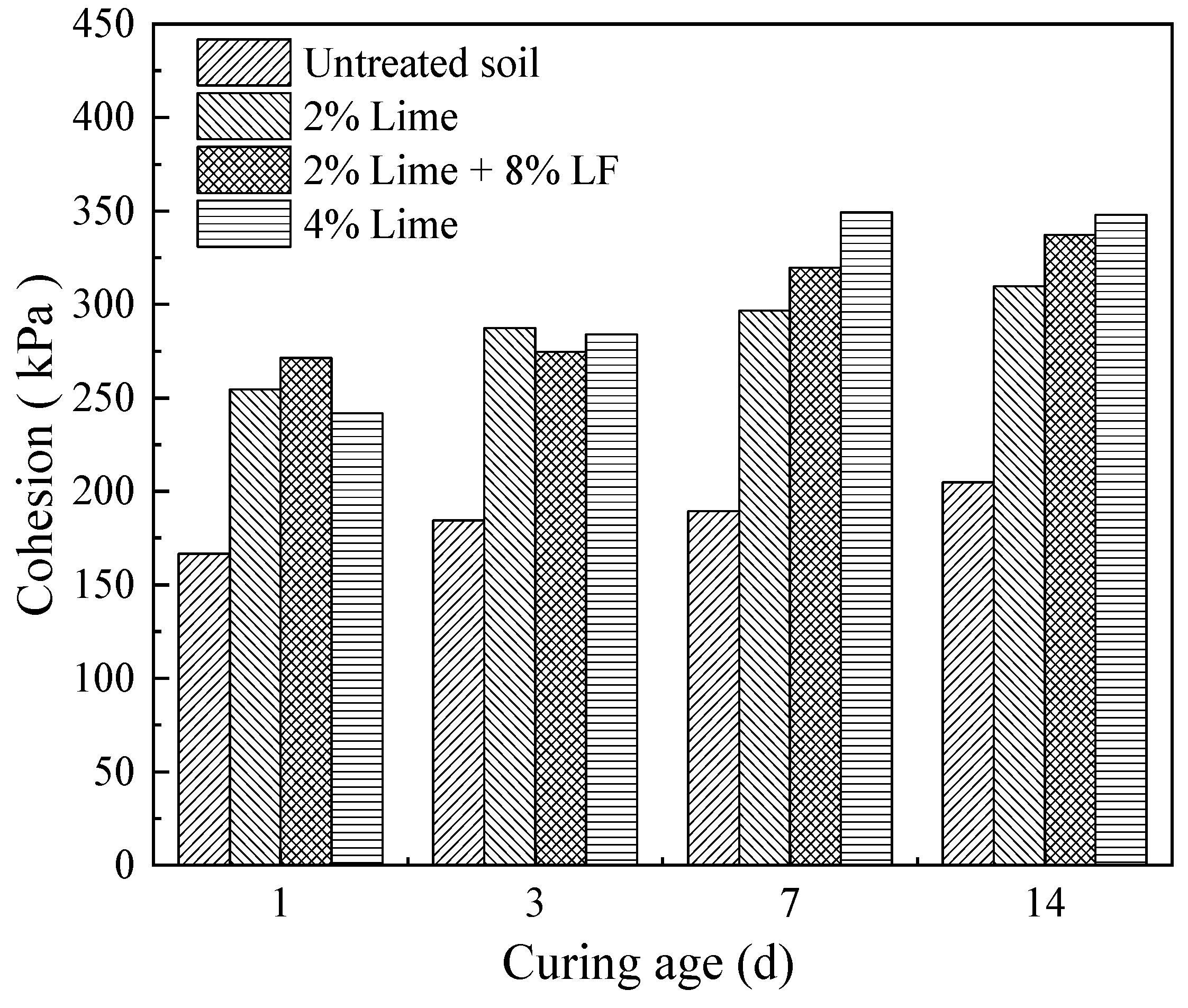



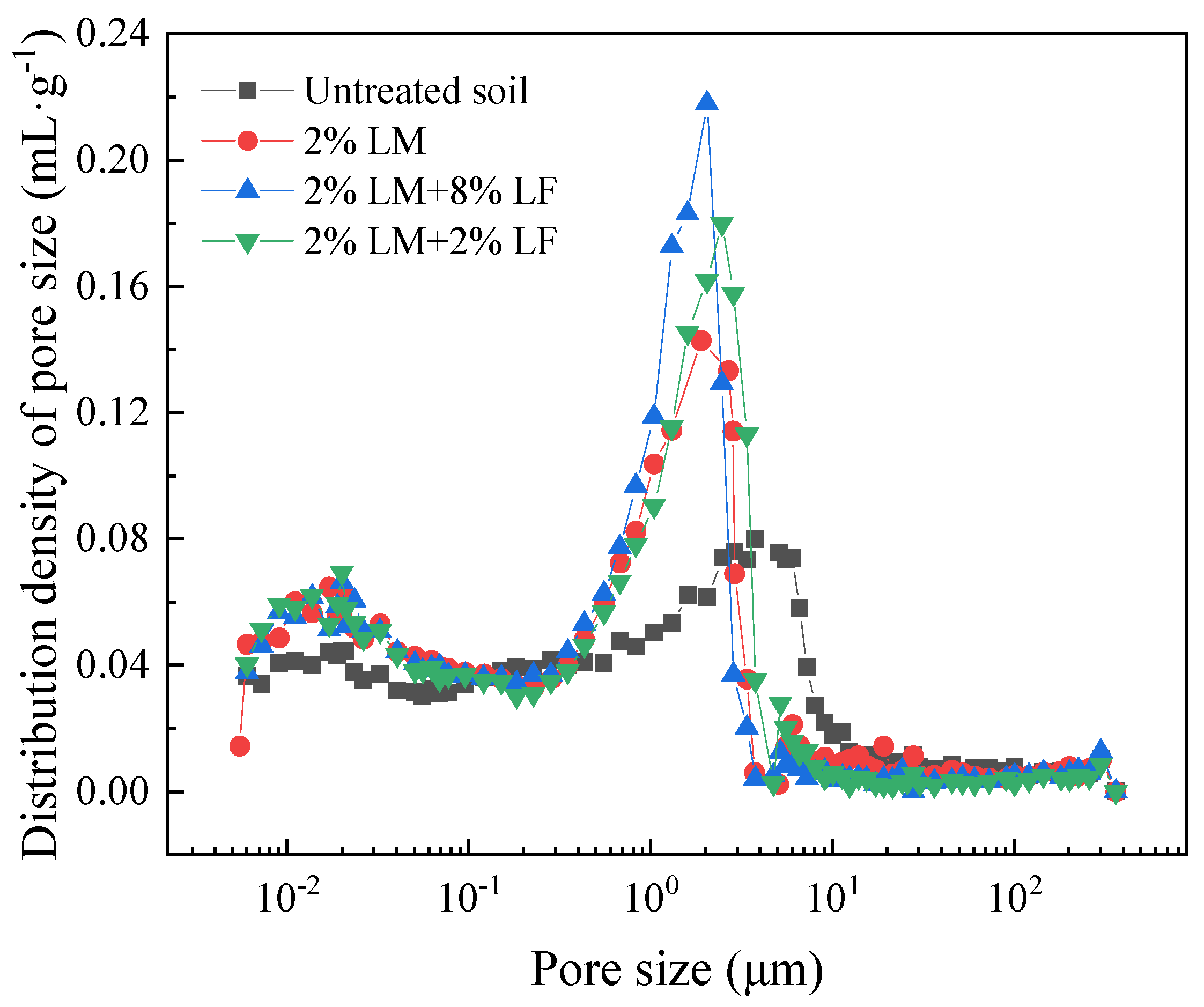
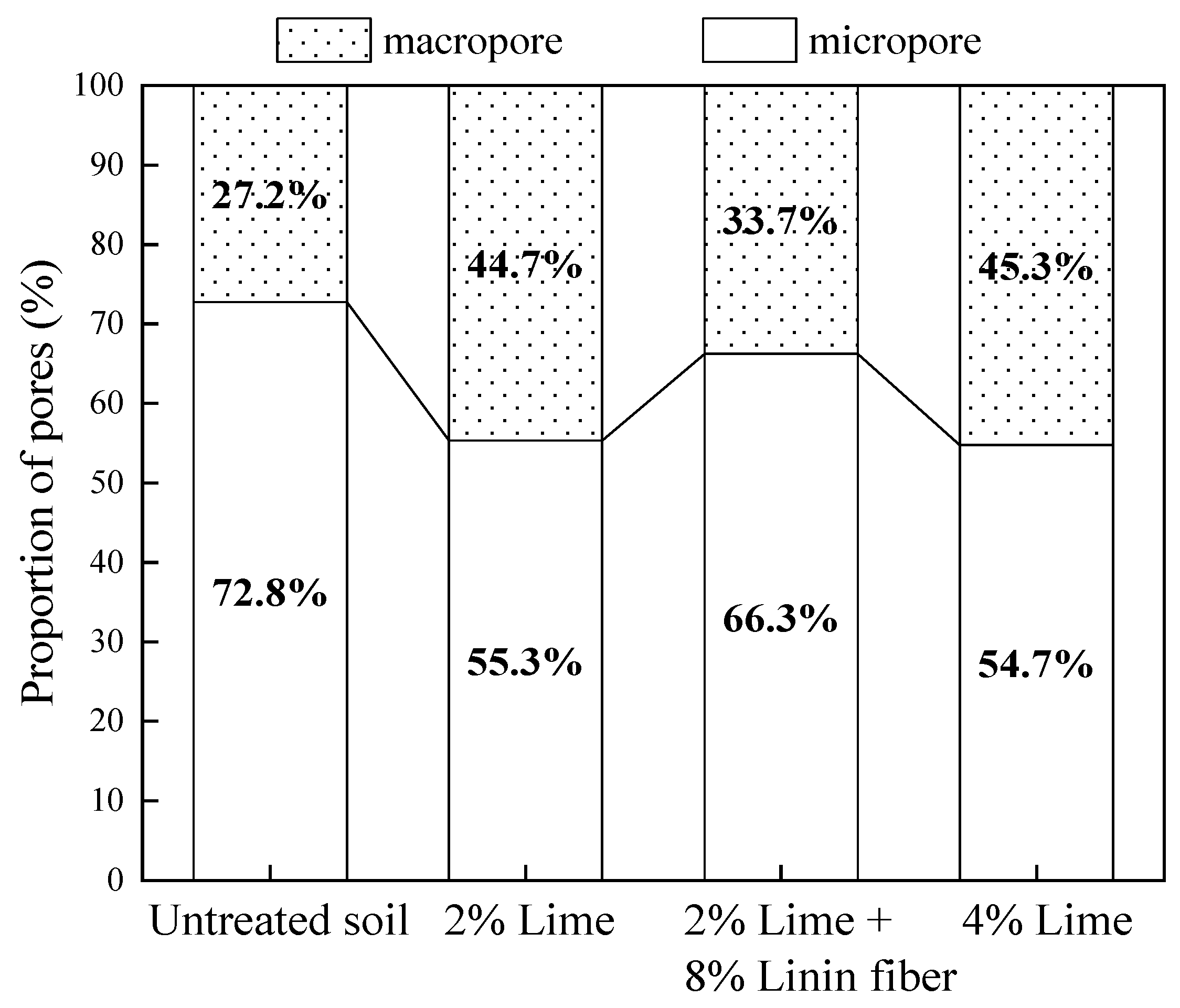

| Liquid Limit /(%) | Plastic Limit /(%) | Plasticity Index | Maximum Dry Density /(g/cm3) | Optimal Moisture Content/(%) | Free Swelling Ratio/(%) |
|---|---|---|---|---|---|
| 58.41 | 33.73 | 24.68 | 1.57 | 22 | 77 |
| Quartz /(%) | Montmorillonite /(%) | Illite /(%) | Plagioclase /(%) | Microcline /(%) | Kaolinite /(%) |
|---|---|---|---|---|---|
| 34 | 24 | 20 | 8 | 7 | 7 |
| Soil Type | Lignin Fiber (LF)/(%) | Lime/(%) | Curing Age/(d) |
|---|---|---|---|
| Prime expansive soil | - | - | - |
| Lignin fiber-improved soil | 2/4/6/8/10 | - | - |
| Lime-improved soil | - | 2/4 | 1/3/7/14 |
| Composite-improved soil | Optimum dosage of lignin fiber | 2 | 1/3/7/14 |
| Lignin Fiber (LF)/(%) | C/(kPa) | φ/(°) | R2 |
|---|---|---|---|
| 0 | 166.83 | 16.12 | 0.923 |
| 2 | 183.46 | 18.46 | 0.922 |
| 4 | 200.64 | 20.39 | 0.931 |
| 6 | 207.51 | 21.23 | 0.932 |
| 8 | 210.53 | 26.00 | 0.972 |
| 10 | 204.16 | 24.44 | 0.969 |
Disclaimer/Publisher’s Note: The statements, opinions and data contained in all publications are solely those of the individual author(s) and contributor(s) and not of MDPI and/or the editor(s). MDPI and/or the editor(s) disclaim responsibility for any injury to people or property resulting from any ideas, methods, instructions or products referred to in the content. |
© 2024 by the authors. Licensee MDPI, Basel, Switzerland. This article is an open access article distributed under the terms and conditions of the Creative Commons Attribution (CC BY) license (https://creativecommons.org/licenses/by/4.0/).
Share and Cite
Wang, T.; Wang, Y. Mechanical and Microstructural Changes in Expansive Soils Treated with Lime and Lignin Fiber from Paper Industry. Appl. Sci. 2024, 14, 3393. https://doi.org/10.3390/app14083393
Wang T, Wang Y. Mechanical and Microstructural Changes in Expansive Soils Treated with Lime and Lignin Fiber from Paper Industry. Applied Sciences. 2024; 14(8):3393. https://doi.org/10.3390/app14083393
Chicago/Turabian StyleWang, Taian, and Yejiao Wang. 2024. "Mechanical and Microstructural Changes in Expansive Soils Treated with Lime and Lignin Fiber from Paper Industry" Applied Sciences 14, no. 8: 3393. https://doi.org/10.3390/app14083393
APA StyleWang, T., & Wang, Y. (2024). Mechanical and Microstructural Changes in Expansive Soils Treated with Lime and Lignin Fiber from Paper Industry. Applied Sciences, 14(8), 3393. https://doi.org/10.3390/app14083393




